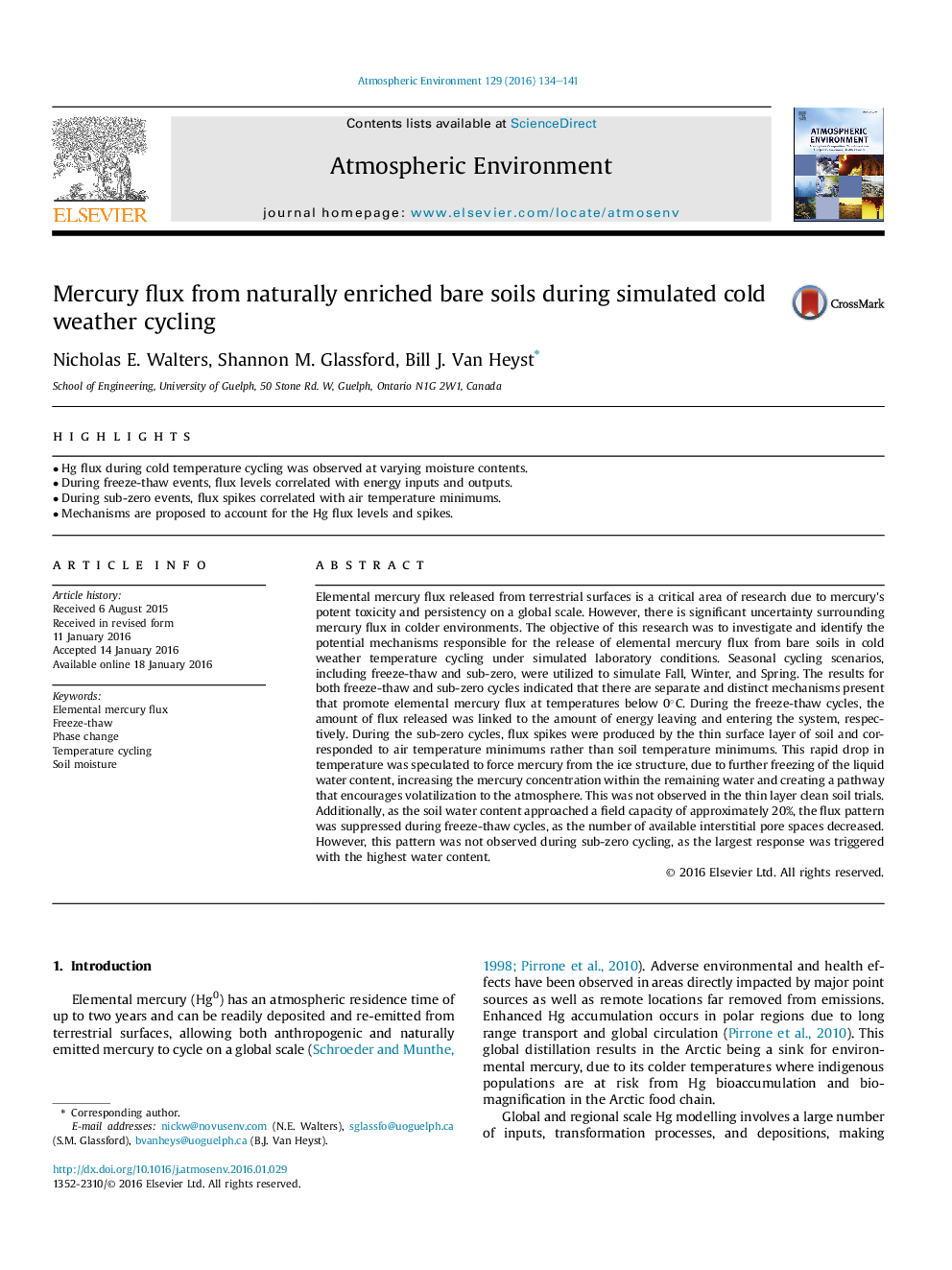| کد مقاله | کد نشریه | سال انتشار | مقاله انگلیسی | نسخه تمام متن |
|---|---|---|---|---|
| 6336809 | 1620345 | 2016 | 8 صفحه PDF | دانلود رایگان |
عنوان انگلیسی مقاله ISI
Mercury flux from naturally enriched bare soils during simulated cold weather cycling
ترجمه فارسی عنوان
جیوه از خاک های خالص غنی شده به طور طبیعی در طول دوچرخه سواری شبیه سازی آب و هوای سرد
دانلود مقاله + سفارش ترجمه
دانلود مقاله ISI انگلیسی
رایگان برای ایرانیان
کلمات کلیدی
شار جیوه عنصری، یخزدن، تغییر فاز، دمای دوچرخه سواری، رطوبت خاک،
ترجمه چکیده
جیوه عنصری که از سطح زمین آزاد می شود، یک منطقه بحرانی تحقیقاتی است که به علت سمیت بودن و پایداری جیوه در مقیاس جهانی است. با این حال، عدم اطمینان قابل توجهی در مورد جریان جیوه در محیط های سرد وجود دارد. هدف از این تحقیق بررسی و شناسایی مکانیسم های بالقوه ناشی از انتشار شار جیانی عنصری از خاک های لعاب در طی دوچرخه سواری در دمای هوای سرد تحت شرایط آزمایشگاهی شبیه سازی شده است. سناریوهای دوچرخه سواری فصلی، از جمله یخ زدگی و زیر صفر، برای شبیه سازی پاییز، زمستان و بهار استفاده شد. نتایج حاصل از چرخه یخ زدن و خنک شدن و صفر صفر نشان می دهد که مکانیزم های جداگانه و متمایز وجود دارد که شار جیانی عنصر را در دماهای زیر 0 درجه سانتی گراد حفظ می کنند. در طول چرخه یخ زدگی، مقدار شارژ آزاد به ترتیب به میزان انرژی خروج و وارد شدن به سیستم مربوط می شود. در طول دوره صفر صفر، سنسورهای شار از طریق سطح نازک سطح خاک تولید شده و به حداقل دمای هوا مطابقت داده می شود، به غیر از حداقل دمای خاک. این افت سریع در دمای پیش بینی شده بود که جیوه از ساخت یخ به دلیل انجماد بیشتر آب مایع، افزایش غلظت جیوه در آب باقی مانده و ایجاد مسیری است که موجب تخلیه در جو می شود. این در آزمایش های خالص خاک در لایه ناز مشاهده نشد. علاوه بر این، به عنوان مقدار آب خاک تقریبا حدود 20 درصد ظرفیت میدان را در بر می گیرد، الگوی شار در طی دوره های یخ زدایی خنثی شد، به طوری که تعداد فضای خالی بین فضایی موجود در آن کاهش یافت. با این حال، این الگو در دوران صفر صفر مشاهده نشد، چرا که بزرگترین پاسخ با بیشترین مقدار آب به وجود آمد.
موضوعات مرتبط
مهندسی و علوم پایه
علوم زمین و سیارات
علم هواشناسی
چکیده انگلیسی
Elemental mercury flux released from terrestrial surfaces is a critical area of research due to mercury's potent toxicity and persistency on a global scale. However, there is significant uncertainty surrounding mercury flux in colder environments. The objective of this research was to investigate and identify the potential mechanisms responsible for the release of elemental mercury flux from bare soils in cold weather temperature cycling under simulated laboratory conditions. Seasonal cycling scenarios, including freeze-thaw and sub-zero, were utilized to simulate Fall, Winter, and Spring. The results for both freeze-thaw and sub-zero cycles indicated that there are separate and distinct mechanisms present that promote elemental mercury flux at temperatures below 0°C. During the freeze-thaw cycles, the amount of flux released was linked to the amount of energy leaving and entering the system, respectively. During the sub-zero cycles, flux spikes were produced by the thin surface layer of soil and corresponded to air temperature minimums rather than soil temperature minimums. This rapid drop in temperature was speculated to force mercury from the ice structure, due to further freezing of the liquid water content, increasing the mercury concentration within the remaining water and creating a pathway that encourages volatilization to the atmosphere. This was not observed in the thin layer clean soil trials. Additionally, as the soil water content approached a field capacity of approximately 20%, the flux pattern was suppressed during freeze-thaw cycles, as the number of available interstitial pore spaces decreased. However, this pattern was not observed during sub-zero cycling, as the largest response was triggered with the highest water content.
ناشر
Database: Elsevier - ScienceDirect (ساینس دایرکت)
Journal: Atmospheric Environment - Volume 129, March 2016, Pages 134-141
Journal: Atmospheric Environment - Volume 129, March 2016, Pages 134-141
نویسندگان
Nicholas E. Walters, Shannon M. Glassford, Bill J. Van Heyst,
